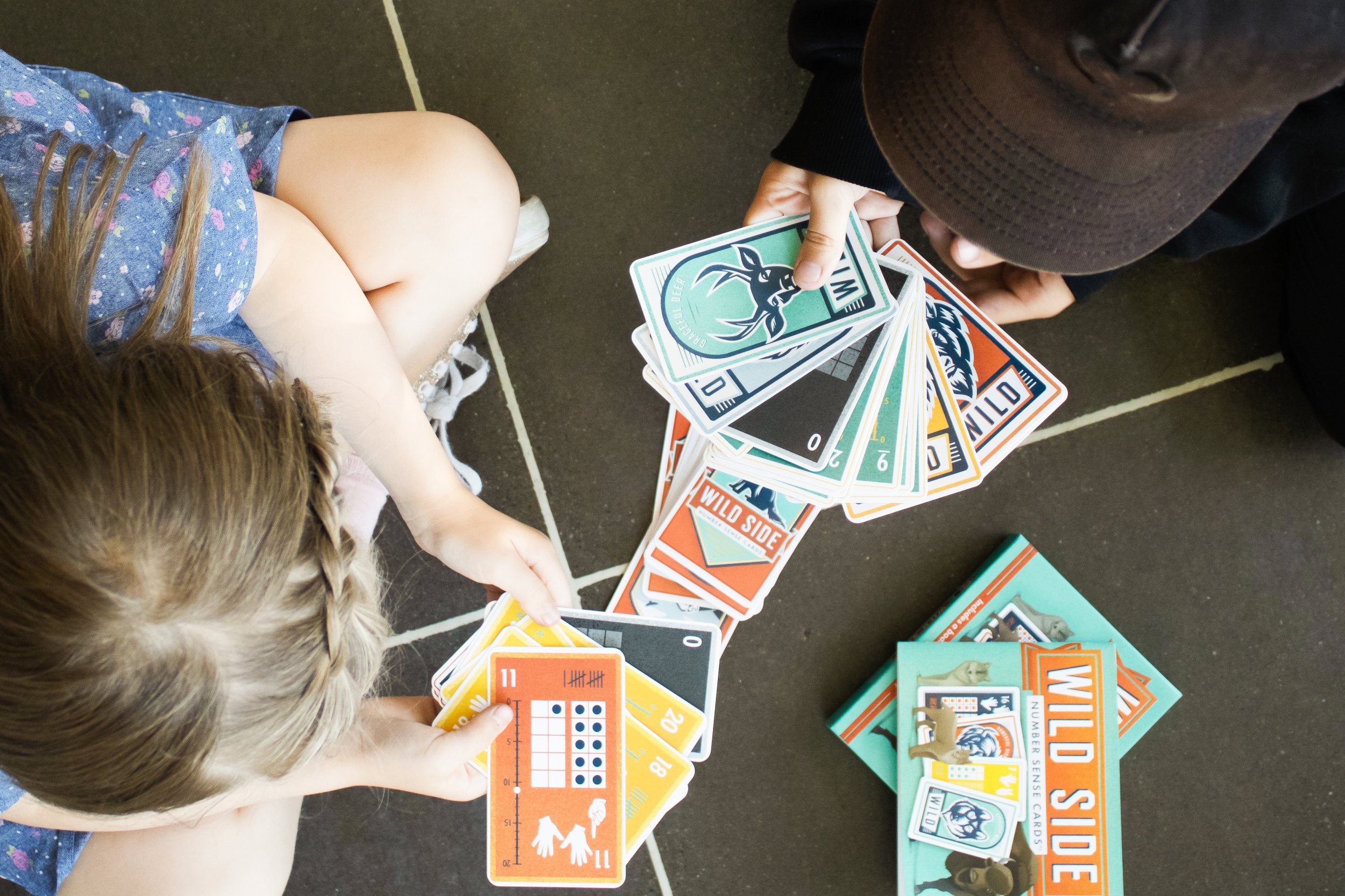A Mental Math Workout to Boost Their Number Sense! (And a Bonus Activity for Younger Learners!)
We have so many ideas popping up, and we are loving the ideas we are hearing about how you are using Wild Side cards in your classrooms and homes! In alternating monthly newsletters, we will highlight a game or activity from the Wild Side games booklet and as always, offering a brand new game or activity not included with the set! This month, we are including a fun game that will have kids adding and subtracting mentally and of course, using those wild cards strategically!
Game Spotlight: There and Back Again
This well-loved game will have kids mentally adding and subtracting to beat their opponent, building fluency and number sense in the context of FUN! There and Back Again is in the grades K-2 section of the Wild Side game booklet, but read on for a variation to add plenty of challenge for older students! In our experience with many students playing this game, it gives kids a huge boost in the ability to think flexibly as they break numbers apart and put them back together to add and subtract quantities!
This game (though not the variation) can be adapted for a standard deck of cards! Full instructions are below and can be found on Page 13 of the Wild Side Number Sense Cards games booklet.
There and Back Again
2 players (up to 4 players for variation)
Skill: Addition and subtraction within 100
* Paper and pencils are needed for this game.
** Place the color-coded +/- card on the table for reference.
Play using cards 0-10 and four wild cards: Divide the deck between the two players, cards facing down. A beginning score of 50 is written at the top of each player’s paper. Each player flips over their first card. If the card is yellow or red, the number is added to the player’s score. If the card is green or blue, the number is subtracted from the player’s score. Calculations are made mentally (or on paper), and a running score is kept. Wild cards can be used as either a + or a – card and can be any number between 0 and 10. When both players have finished their calculations, another card is turned over by each player, a new equation is made, and a new total is calculated. Play continues until all cards are used.
Winning the game: The player with a final score closest to 50 is the winter.
Variation using cards 0-20 and 8 wild cards: For learners familiar with addition and subtraction beyond 100, use cards 0-20 with 2-4 players. A beginning score of 100 (or 200, 300, etc) is used. The winner is the player with the final score closest to the beginning score.
Bonus Activity
Numbers to Twelve
Individual activity (for young learners who can count to 12)
Skills: Ordering Numbers, Adding Numbers to Twelve, Subtracting Numbers from Six or Less
Materials: One Set of Number Cards, 0-12 and Two Dice
Note: For this activity, your learner needs to be able to count to twelve. They do not necessarily need to know what these numerals looks like! Your learner should also be able to add dots on two dice to add to twelve or less. In this activity, kids can use addition only, or they can use subtraction skills as well to arrive at target numbers. If they are ONLY able to add, use cards 2 through 12. Subtraction skills are necessary for including numbers zero and one. Children may count the dots on each dice one by one to add, or you may take this opportunity to teach children to “count on.” In counting on, a child will choose the larger number of dots, say the number, and then count on from there on the second dice to arrive at the sum of both dice.
Children will be working on adding (and subtracting if able) numbers on a dice and counting without seeing numbers on a card.
How to play
1. Place the cards in order from zero to twelve in front of the child.
2. Then turn the cards over so they are face down, remaining in order. (If you are not planning to use subtraction skills, leave cards zero and one face up.
3. The child rolls two dice and adds the total of the dice. They then count the cards beginning at zero until they get to the card that equals that sum. Turn that card face up.
4. For children who do not yet recognize numerals, have them count the dots on the ten frame(s), or the fingers on the hands to check their answer.
5. Continue until all twelve cards have been revealed. If the child rolls the dice and has already turned that card over, they roll again until they arrive at a number that they haven’t turned over.
6. Play continues until all numbers have been revealed. CELEBRATION TIME!!!
Variation:
At any point in this activity, you may introduce the option of using subtraction to arrive at the desired number. Again, subtraction is a difficult concept for young learners. Subtracting from viewing two numbers on dice is abstract. You can encourage the child to tell you which die has the largest number, name that number and then have them hold up that many fingers. If each of the dice has the same number, ask the child to hold up the number of fingers from one die. From there, they can put back down fingers for each dot on the second die.
We know your learners will have fun playing There and Back Again and Numbers to Twelve, and YOU will have fun watching them build confidence and fluency!
Thank you for spreading a love of math!

